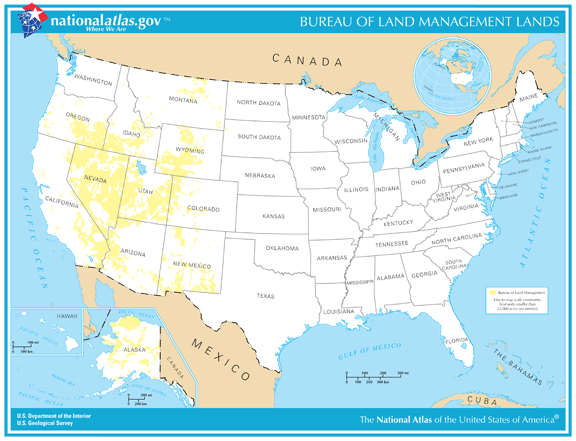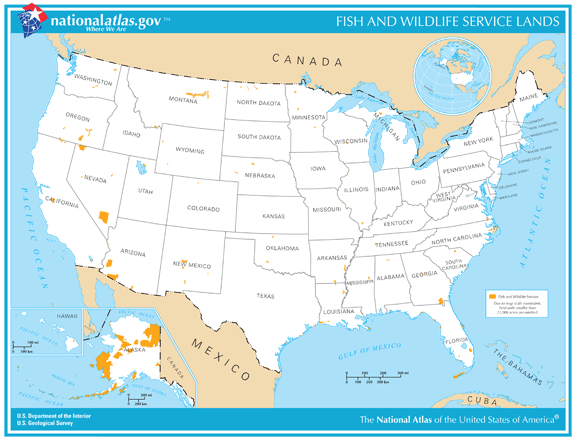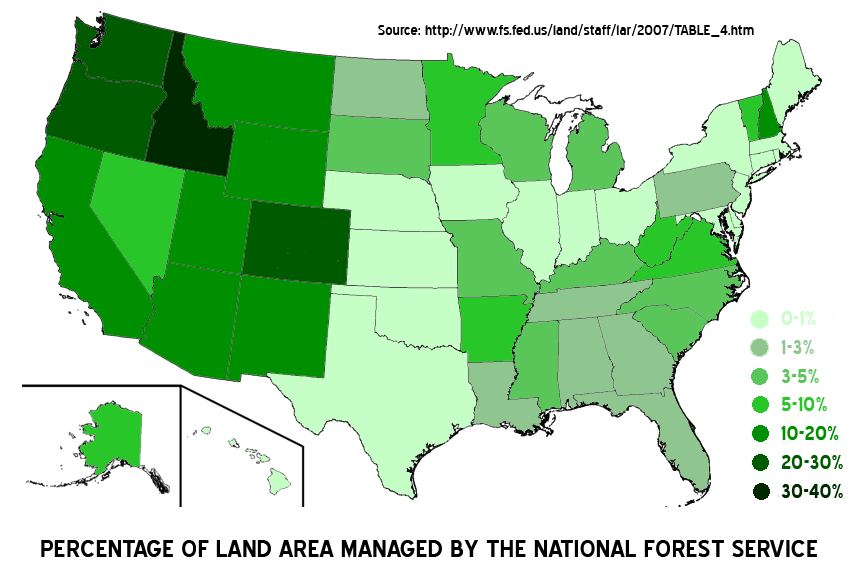Honors 3900
New Policies
- maps from the National Atlas.gov
- history of the Department of the Interior
- history of BLM
- history of Bureau of Reclamation
- history of the Fish & Wildlife Service
- history of the National Park Service
- history of U.S. Forest Service
- history of Land Grant Colleges
- from the Library of Congress, The Evolution of the Conservation Movement, 1850-1920
American Progress by John Gast, circa 1872
The Federal Government owns nearly 650 million acres of land - almost 30 percent of the land area of the United States. Federally-owned and managed public lands include National Parks, National Forests, and National Wildlife Refuges. These are lands that are held for all Americans. The Federal agencies responsible for managing America's natural resources must meet both the public desire to protect them and the public expectation of economic growth based on them. Within the Federal Government, a number of agencies contribute to the management of natural resources associated with public lands
In 1789 Congress created three Executive Departments: Foreign Affairs (later in the same year renamed State), Treasury, and War. It also provided for an Attorney General and a Postmaster General. Domestic matters were apportioned by Congress among these departments. The idea of setting up a separate department to handle domestic matters was put forward on numerous occasions. It wasn't until March 3, 1849, the last day of the 30th Congress, that a bill was passed to create the Department of the Interior to take charge of the Nation's internal affairs.
- 1856-1873 Interior's Pacific Wagon Road Office improved the historic western emigrant routes.
- 1869 Interior began its geological survey of the western Territories with the Hayden expedition.
- 1872 Congress establishes Yellowstone as the first National Park.
- 1873 Congress transferred territorial oversight from the Secretary of State to the Secretary of the Interior.
- 1879 Creation of the U.S. Geological Survey.
- 1902 The Bureau of Reclamation is established to construct dams and aqueducts in the west.
- 1903 President Theodore Roosevelt establishes the first National Wildlife Refuge at Pelican Island, Florida.
- 1934 The Taylor Grazing Act is enacted to regulate economic uses of public lands. The first Migratory Bird Hunting Stamp is issued. The Indian Reorganization Act abolishes the allotment system established in 1887, forms tribal governments, and affirms the Secretary's trust responsibilities. Oversight of Alaska, Hawaii, the Virgin Islands, and Puerto Rico is transferred to Interior.
- 1935 The Bureau of Reclamation completes construction of Hoover Dam.
- 1940 The U.S. Fish and Wildlife Service is created from the Bureau of Fisheries and the Bureau of Biological Survey.
- 1946 Interior's General Land Office and Grazing Service are merged into the Bureau of Land Management.

The Bureau of Land Management was formed during a government reorganization in 1946, combining two former federal agencies -- the General Land Office and the U.S. Grazing Service. Most of the land managed by the BLM is located in 12 western states, including Alaska, although small parcels are scattered throughout the East. Besides protecting and managing the public lands for a variety of uses, the BLM also maintains custody of nearly nine million pages of historic land documents. These documents include copies of homestead and sales patents, survey plats and survey field notes.
Mission: To sustain the health, productivity, and diversity of the public lands for the use and enjoyment of present and future generations.

In July 1902, in accordance with the Reclamation Act, Secretary of the Interior Ethan Allen Hitchcock established the U.S. Reclamation Service within the U.S. Geologic Survey (USGS). The new Reclamation Service studied potential water development projects in each western state with federal lands—revenue from sale of federal lands was the initial source of the program's funding. From 1902 to 1907, Reclamation began about 30 projects in Western states.Then, in 1907, the Secretary of the Interior separated the Reclamation Service from the USGS and created an independent bureau within the Department of the Interior.
In the jargon of that day, irrigation projects were known as "reclamation"projects. The concept was that irrigation would "reclaim" arid lands for human use. In addition, "homemaking" was a key argument for supporters of reclamation. Irrigation's supporters believed reclamation programs would encourage Western settlement, making homes for Americans on family farms. President Theodore Roosevelt supported the reclamation movement because of his personal experience in the West, and because he believed in homemaking.


http://www.nceas.ucsb.edu/scicomp/usecases/CreateMapsWithRGraphics
| 1871 | U.S. Commission on Fish and Fisheries is created by Congress and charged with studying and recommending solutions to the decline in food fishes and to promote fish culture. Spencer Fullerton Baird is appointed as the first Commissioner. A year later, the Commission's Baird Station in northern California is used to collect, fertilize and ship salmon eggs by rail to the East Coast. |
| 1885 | Division of Economic Ornithology and Mammalogy is established in the Department of Agriculture. With Clinton Hart Merriam appointed as its first Chief, much of the Division's early work focuses on studying the positive effects of birds in controlling agricultural pests and defining the geographical distribution of animals and plants throughout the country. The Division later expands and is renamed the Bureau of Biological Survey. |
| 1900 | The Lacey Act becomes the first Federal law protecting game, prohibiting the interstate shipment of illegally taken wildlife and importation of species. Enforcement of the Act becomes the responsibility of the Biological Survey. |
| 1903 | The first Federal Bird Reservation is established by President Theodore Roosevelt on Pelican Island, Florida, and placed under the jurisdiction of the Biological Survey. Pelican Island and other early Federal wildlife reservations are re- designated as "national wildlife refuges" in 1942. |
| 1918 | Migratory Bird Treaty Act is passed implementing the Convention Between the United States and Great Britain (for Canada) for the Protection of Migratory Birds. The Act, a landmark in wildlife conservation legislation, provides for the regulation of migratory bird hunting. |

On August 25, 1916, President Woodrow Wilson approved legislation creating the National Park Service within the Interior Department. The act made the bureau responsible for Interior's national parks and monuments, Hot Springs Reservation in Arkansas (made a national park in 1921), and "such other national parks and reservations of like character as may be hereafter created by Congress." In managing these areas, the Park Service was directed "to conserve the scenery and the natural and historic objects and the wild life therein and to provide for the enjoyment of the same in such manner and by such means as will leave them unimpaired for the enjoyment of future generations."

The national forests (at first called forest reserves) began with the Forest Reserve Act of 1891, which allowed the president to establish forest reserves from timber covered public domain land. (This act repealed the Timber Culture Act of 1873.) Several early leaders and visionaries, along with willing presidents (especially Teddy Roosevelt), scientific and conservation organizations, and newly trained forestry professionals, led the successful effort in retaining millions of acres of federal forest land for future generations.
In 1907 the reserves were renamed national forests. The next year, six district offices were organized in the West for field work. The establishment of national forests in the East began after President Taft signed the Weeks Law in 1911, which created the National Forest Reservation Commission, and authorized federal funds to purchase lands on the watersheds of navigable streams. By 1934, 10 regions existed: Northern, Rocky Mountain, Southwestern, Intermountain, California, North Pacific, Eastern, Southern, North Central, and Alaska. In addition, there were 11 forest and range experiment stations.



